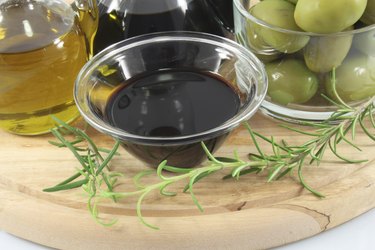
You want to uplift balsamic's rich balance of tart and sweet when you infuse it, using a gentle hand to layer light flavors and floral aromas that work with the vinegar, not against it. Balsamic has a heady flavor and aroma on its own. And although it's unlikely you'll mask it during an infusion, you can easily confuse it if you use cloying fruits and pungent herbs. Keep the infusion simple, add light fruits and floral herbs, and test it throughout the process until you're happy with the flavor and aroma for optimum results.
Choosing a Balsamic
Video of the Day
True balsamics you find in the grocery store are "Industriale," or quick-processed balsamic vinegars, that have a zero-to-four rating with a leaf graphic representing the rating on the "Qualita Certificata" label on the bottle. Aged balsamics, sold mainly in boutique shops, have gold, silver or red labels that indicate quality and caps that denote age. Then you have the imitations, found in warehouse stores and supermarkets, which have no rating and sell for as little as $5 for 8 ounces.
Video of the Day
For infusions, you want a zero- or one-leaf-rated "Industriale," if you can get it; infusing a high-quality, aged balsamic with fruits and herbs is tantamount to spray-painting over the Mona Lisa. If all you can find are imitation balsamics, that's fine too; if you don't like the infusion, all you lose is time. You can find a zero- or one-leaf-rated balsamic for about $20 at most supermarkets.
Selecting Fruits
Test the fruit you want to infuse with a drop or two of balsamic for a taste test; this gives you best idea of the flavor an infusion brings. The first, and most obvious choice, for a balsamic infusion is figs. Figs practically scream for a balsamic infusion. Normally anointed with a fine, aged balsamic and served after a meal, figs' sultry-sweet, complex flavor aligns so well with that of balsamic some small specialty stores sell their own fig-infused, aged balsamic. The next choice is grapes. Balsamic gets its acid from grape must -- fresh grape juice pressed with the skins and stems -- so grapes are a natural fit. Strawberries and peaches pair well with balsamic, too. Test what fruits you have in mind before you infuse, and you can't lose.
Picking the Herbs
For herbal infusions, always go with fresh herbs. The seductive aroma that wafts around you as you muddle a melange of freshly picked herbs in a mortar and pestle inspires you and your infusion. You want floral, woodsy notes with balsamic. Rosemary, sage, thyme and basil are natural candidates, as are laurel and mint. But as with fruit, use your palate before you decide. Taste a spoonful of balsamic with a few shreds of herbs in it and chew to see if you like what you experience. If you find something you like, you've found your herbs.
The Technique
Remove the stems and seeds from the fruit and crush it in a heavy-bottomed saucepan using a wooden spoon. Muddle the herbs in a mortar and pestle and add them to the saucepan; add enough balsamic to cover the fruit and bring it to a simmer. Simmer the balsamic for about a minute then pour it in a glass jar. Let the vinegar cool, seal the jar and place it in a cool place to steep. Taste the vinegar after a week, then decide if it needs more time. When it's ready, strain the vinegar through a sieve lined with cheesecloth and store it in the refrigerator indefinitely; if the vinegar develops an off odor or taste, discard it.